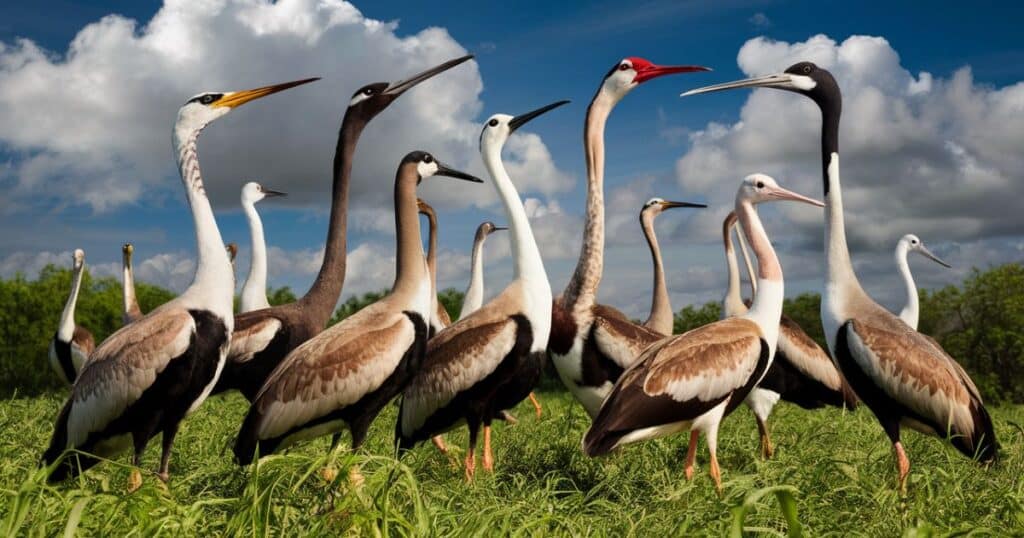Have you ever marveled at the beautiful birds gracefully wading in shallow waters, their long necks elegantly stretched as they hunt for their next meal? These amazing birds are not just a feast for the eyes but also a testament to the incredible adaptability of nature. From the vibrant pink flamingos to the regal cranes, magical birds with long necks have captured our imaginations and enchanted us with their stunning elegance.
Understanding Long Necks in Birds
Before we delve into the diverse array of long-necked birds, it’s essential to understand the evolutionary significance and mechanics behind this remarkable adaptation.
What are Long Necks Made Of?
Long necks in birds are primarily composed of a series of lightweight yet sturdy vertebrae, flexible muscles, and connective tissues. The number of cervical (neck) vertebrae can vary greatly among species, with some birds boasting over 20 vertebrae in their necks. This unique anatomical structure allows these birds with long necks to extend, retract, and maneuver their necks with remarkable dexterity.
MORE POST: The Mysterious Opium Bird: Is It Real Or Just A Tall Tale?
What Constitutes the Long Neck?
While there is no definitive threshold, ornithologists generally consider a neck to be “long” when it exceeds half the body length of the bird. This adaptation enables long-necked birds to access food sources in hard-to-reach areas, catch elusive prey in the water, and engage in captivating courtship displays and territorial behaviors.
Compared to Other Animals, Birds Have Different Necks?
Unlike many other vertebrates, birds lack cervical (neck) ribs, which contributes to their increased neck flexibility and range of motion. Additionally, the unique construction of avian necks, with lightweight yet strong vertebrae and specialized muscle arrangements, enables them to perform remarkable feats, such as the ability to tuck their heads back against their bodies or stretch their necks to their full lengths.
What is the Evolutionary Path of Birds with Long Necks?
The evolution of long necks in birds is believed to be an adaptation for various ecological niches and feeding strategies. Birds with long necks that forage in aquatic environments, such as herons and flamingos, developed elongated necks to reach prey in shallow waters or wetlands. Similarly, long necks in cranes and other wading birds allow them to access food sources in tall grasses or marshes. This adaptation has proven to be a highly successful survival strategy for many avian species.
Prehistoric Birds with Long Necks
The fossil record reveals that long-necked birds have existed for millions of years. For example, the Prehistoric Dromornithidae, also known as “Demon Ducks,” were massive, flightless birds with elongated necks that roamed Australia during the Cenozoic Era. The evolution of long necks in birds has been a successful adaptation across various lineages and environments, showcasing the remarkable diversity and resilience of these elegant creatures.
Birds with Long Necks Around the World
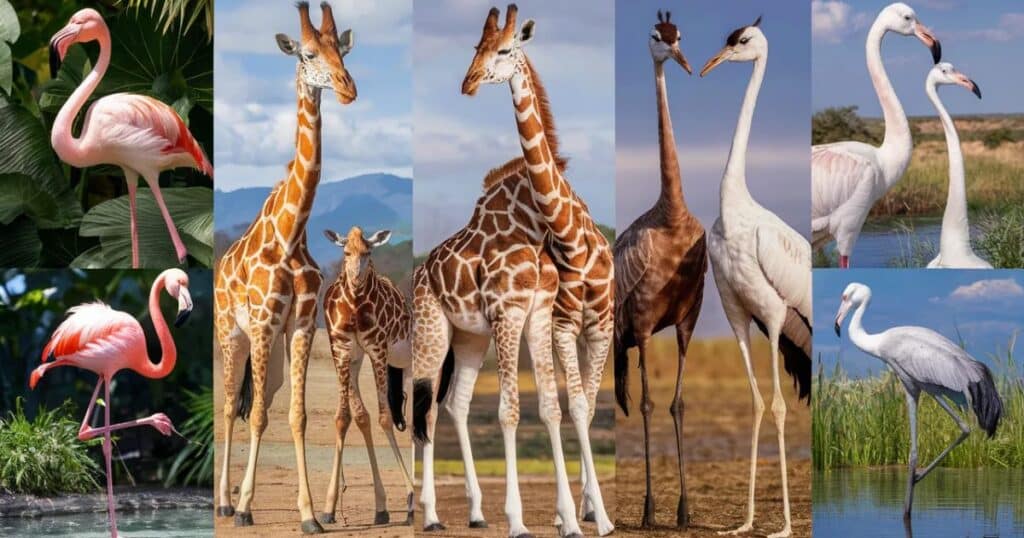
Now that we have a deeper understanding of the significance and mechanics of long necks in birds, let’s embark on a journey around the globe to explore some of the most captivating species that exemplify this remarkable adaptation.
North America
- Sandhill Crane, Antigone canadensis
With a neck nearly as long as its body, the Sandhill Crane is a graceful and iconic bird of North America. These migratory birds are renowned for their intricate courtship dances and their distinctive rattling calls. Watching them extend their long necks in synchronized movements is truly a sight to behold.
- American Flamingo, Phoenicopterus ruber
The vibrant pink American Flamingo is a distinctive sight in the wetlands and coastal regions of the southern United States and Caribbean. Their long, curved necks and specialized beaks allow them to filter feed on algae and small crustaceans. These elegant birds often stand on one leg, further emphasizing the beauty of their long necks.
- Tricolored Heron, Egretta tricolor
Found in coastal areas and marshes of the southeastern United States, the Tricolored Heron is aptly named for its striking plumage. Its long, slender neck enables it to hunt for small fish, crustaceans, and amphibians in shallow waters. These patient hunters will often stand motionless for hours, their long necks poised to strike at the perfect moment.
South America
- Scarlet Ibis, Eudocimus ruber
The Scarlet Ibis, native to South America and the Caribbean, is a stunning bird with a long, curved neck and brilliant scarlet plumage. These wading birds congregate in large flocks and use their elongated necks to forage for crustaceans and aquatic insects in wetlands and mangrove forests.
- Roseate Spoonbill, Platalea ajaja
With its distinctive spoon-shaped bill and long, slender neck, the Roseate Spoonbill is a captivating sight in the wetlands and mangrove forests of South America. These pink-hued birds use their specialized beaks and long necks to sweep through shallow waters in search of small aquatic creatures.
- White-faced Ibis, Plegadis chihi
The White-faced Ibis, found in South America and parts of North America, is a wading bird with a long, decurved neck and distinct facial markings. These social birds forage in shallow wetlands and marshes, using their elongated necks to probe for insects, crustaceans, and small fish.
Europe
- European Spoonbill, Platalea leucorodia
Similar to its American cousin, the European Spoonbill is a striking white wading bird with a long, slender neck and a distinctive spoon-shaped bill. These birds can be found in marshes, estuaries, and coastal areas across Europe and parts of Asia, gracefully extending their long necks as they forage for aquatic prey.
- Bewick’s Swan, Cygnus columbianus bewickii
The elegant Bewick’s Swan is a migratory bird that breeds in the Arctic regions of Europe and Asia. With its long, graceful neck and white plumage, it is a beautiful sight in the wetlands and lakes of its wintering grounds. These swans often use their long necks to reach for aquatic vegetation and engage in courtship displays.
- Grey Heron, Ardea cinerea
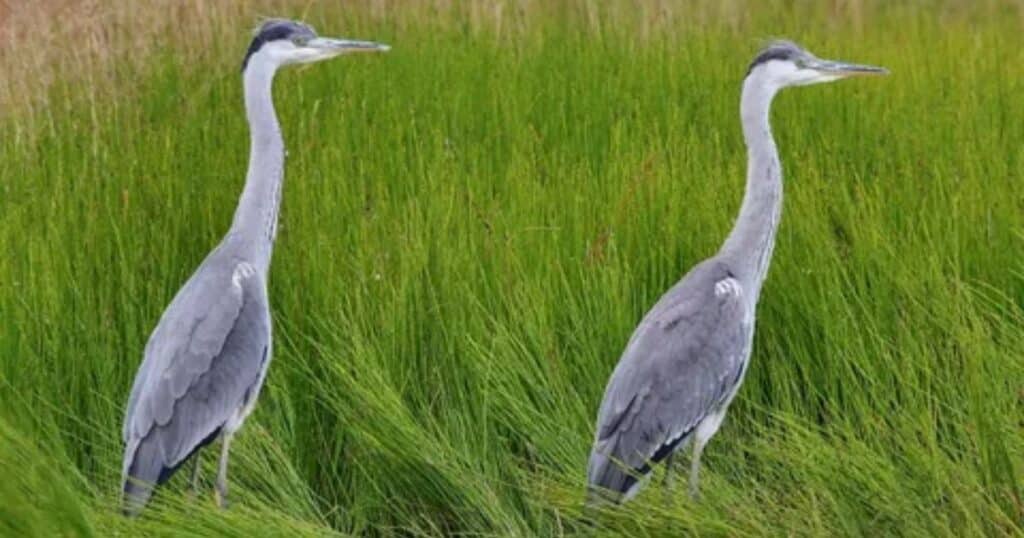
The Grey Heron is a widespread and well-known wading bird found throughout Europe, Asia, and parts of Africa. Its long, slender neck and dagger-like bill make it an efficient hunter of fish, amphibians, and small mammals in shallow waters and wetlands. These patient hunters will often stand motionless for hours, their long necks poised to strike at the perfect moment.
Australia
- Black-Necked Stork, Ephippiorhynchus asiaticus australis
The Black-Necked Stork, also known as the Jabiru, is a striking and massive wading bird found in the wetlands and savannas of northern Australia. Its long, thick neck and massive bill make it a formidable predator, capable of catching prey as large as small mammals and reptiles.
- Cattle Egret, Bubulcus ibis
Although not native to Australia, the Cattle Egret has established itself as a common sight across the continent. These small, long-necked herons often forage alongside livestock, using their slender necks to catch insects and other small prey disturbed by the grazing animals.
- Black Swan, Cygnus atratus
The Black Swan is an iconic and graceful bird found in wetlands and rivers across Australia. With its long, curved neck and striking black plumage, it is a beautiful and unmistakable sight on the water. These swans often use their long necks to reach for aquatic vegetation and engage in courtship displays.
Africa
- Black-headed Heron, Ardea melanocephala
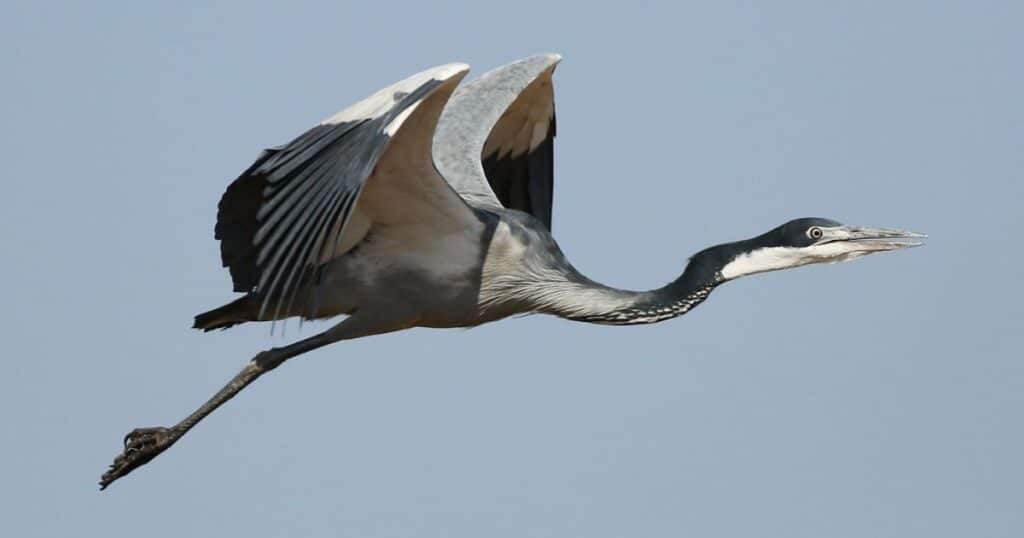
The Black-headed Heron, found in sub-Saharan Africa, is a striking wading bird with a long, slender neck and distinctive black head. These birds are adept hunters, using their elongated necks to catch fish, frogs, and other aquatic prey in shallow waters and wetlands.
- Ostrich, Struthio camelus
The Ostrich, the largest living bird species, is native to the savannas and semi-arid regions of Africa. While not typically considered a long-necked bird, the Ostrich’s neck is remarkably long and flexible, enabling it to scan the horizon for potential threats or food sources on the ground.
- Kori Bustard, Ardeotis kori
The Kori Bustard, found in the savannas and grasslands of eastern and southern Africa, is the heaviest flying bird in the world. Despite its large size, it possesses a long, slender neck that helps it forage for insects, seeds, and small vertebrates among the tall grasses. This remarkable adaptation allows the Kori Bustard to thrive in its unique habitat.
Individual Birds with Long Necks
While the previous sections highlighted birds with long necks from various regions, it’s worth delving deeper into some of the most captivating individual species that exemplify this remarkable adaptation.
Ostrich
As the largest living bird species, the Ostrich’s long neck is a remarkable adaptation that allows it to survey its surroundings and reach for food sources on the ground. Despite its size, the Ostrich’s neck is incredibly flexible, enabling it to tuck its head against its body or stretch it out to its full length of nearly three feet.
Interestingly, the Ostrich’s neck plays a crucial role in regulating its body temperature. By dilating or constricting the blood vessels in its neck, the Ostrich can effectively control heat dissipation and maintain a comfortable body temperature in the harsh African savannas.
Flamingo
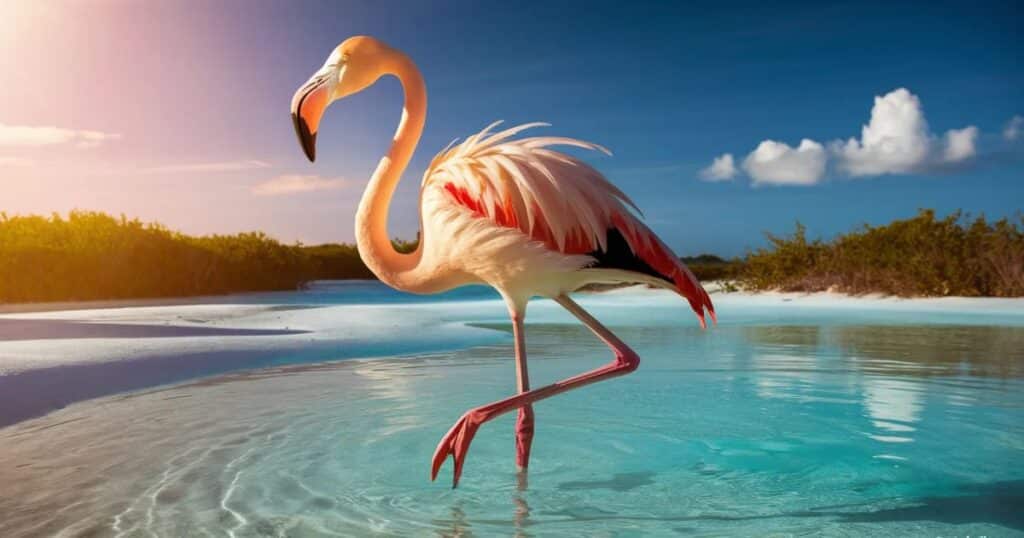
Flamingos are perhaps the most iconic and recognizable long-necked birds. Their unique neck structure, with its distinctive S-shaped curve, allows them to feed upside-down in shallow waters. By sweeping their specialized beaks through the water, flamingos can efficiently filter out algae, brine shrimp, and other tiny aquatic creatures.
The long necks of flamingos are not just functional but also contribute to their striking appearance. These beautiful birds often stand on one leg, with their long necks gracefully curved, creating a picture-perfect image that has inspired artists and photographers for centuries.
Swan
Swans are among the most graceful and elegant of the long-necked birds. Their elongated necks, often held in a gentle curve, are not only beautiful but also functional. Swans use their long necks to reach for aquatic vegetation and to engage in courtship displays and territorial behaviors.
One of the most remarkable adaptations of swans is their ability to use their necks as a powerful defense mechanism. If threatened, a swan can strike with its neck, delivering a forceful blow with its powerful wings. This adaptation has earned them a reputation for being fierce protectors of their territory and offspring.
Crane
Cranes are renowned for their impressive courtship dances, which involve intricate movements and posturing with their long necks. These wading birds use their elongated necks to attract mates and establish dominance within their social groups.
In addition to their courtship rituals, cranes also rely on their long necks for foraging and hunting. With their keen eyesight and ability to extend their necks to great heights, they can spot prey from a distance and strike with precision, capturing small mammals, reptiles, and amphibians.
Great Blue Heron
The Great Blue Heron is a striking wading bird found across North America. With its long, slender neck and distinctive plumage, it is a familiar sight along rivers, lakes, and coastal areas. These patient hunters will often stand motionless for hours, their long necks poised to strike at the perfect moment when prey comes within reach.
One of the most fascinating aspects of the Great Blue Heron is its ability to use its long neck to strike with lightning speed and precision. These birds have evolved to be efficient hunters, capable of catching a wide variety of aquatic prey, including fish, frogs, and small mammals.
Egret
Egrets are a family of small, graceful wading birds known for their striking white plumage and long, slender necks. These birds are often found in wetlands, marshes, and coastal areas, where they use their elongated necks to forage for small fish, crustaceans, and insects.
The long necks of egrets allow them to access hard-to-reach areas and navigate through dense vegetation with ease. Additionally, their ability to extend their necks and strike with precision makes them formidable hunters, capable of capturing even the most elusive prey.
Canada Goose
While not typically associated with long necks, the Canada Goose possesses a remarkably elongated neck that plays a crucial role in its survival and adaptability. These large waterfowl use their long necks to reach for aquatic vegetation and graze on land, allowing them to thrive in a variety of habitats.
During migration, the long necks of Canada Geese also serve an important purpose. By stretching out their necks, these birds can maintain a more streamlined shape, which reduces air resistance and increases their overall efficiency during long-distance flights.
Spoonbill
Spoonbills are a unique group of wading birds that are easily recognized by their distinctive spoon-shaped bills and long, slender necks. These birds use their specialized beaks and elongated necks to forage in shallow waters, sweeping their bills from side to side to capture small aquatic creatures.
The long necks of spoonbills not only aid in their feeding but also contribute to their striking appearance. Whether in flight or wading through wetlands, these beautiful birds with their long necks and bright plumage are a true sight to behold.
Darter
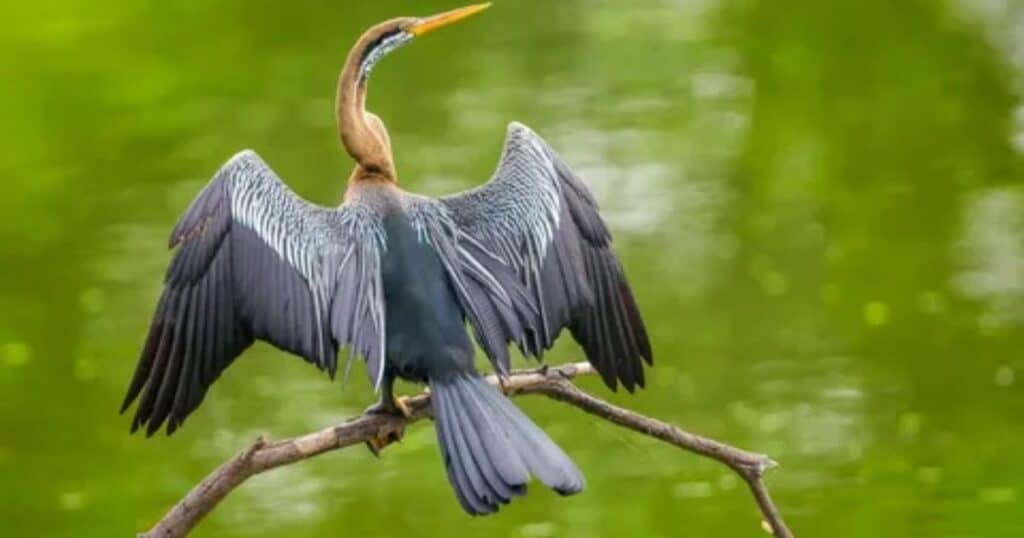
The Darter, also known as the Snake Bird or Anhinga, is a unique water bird found in warm regions around the world. These birds are characterized by their long, slender necks and the ability to swim with just their snake-like heads and necks exposed above the water’s surface.
The long necks of Darters are not only essential for their underwater hunting techniques but also serve as a remarkable adaptation for thermoregulation. These birds can spread their wings and extend their necks to maximize surface area and effectively dry their feathers after a swim.
Whooping Crane
The Whooping Crane is one of the rarest and most endangered bird species in North America. These majestic birds are known for their long, slender necks and distinctive courtship dances, which involve intricate movements and posturing with their elongated necks.
The long necks of Whooping Cranes not only play a crucial role in their courtship rituals but also aid in their foraging and hunting behaviors. These birds use their keen eyesight and ability to extend their necks to great heights to spot prey from a distance and strike with precision.
Fun Facts About Birds with Long Necks
Now that we’ve explored the diverse array of long-necked birds from around the world, let’s delve into some fascinating and often surprising facts about these remarkable creatures:
- Many long-necked birds can tuck their heads back against their bodies, allowing them to rest comfortably or streamline their shape for flight.
- Some species, like the Flamingo, have specialized cervical vertebrae that form a unique S-shaped curve, enabling them to feed upside-down in shallow waters.
- The Great Blue Heron can extend its neck at an incredible speed of up to 230 miles per hour, making it one of the fastest neck movements in the animal kingdom.
- The Ostrich, despite its massive size, can run at speeds of up to 43 miles per hour, thanks in part to its flexible and lightweight neck.
- Whooping Cranes have been known to perform elaborate courtship dances, involving intricate movements with their long necks, to attract mates and establish dominance.
- Some long-necked birds, like the Darter, can swim with just their heads and necks exposed above the water’s surface, using their elongated necks for hunting and thermoregulation.
- The Kori Bustard, the heaviest flying bird, uses its long neck to forage for food among tall grasses, giving it an advantage over other ground-dwelling birds.
- Flamingos can spend up to 30% of their day with their heads upside down in the water, thanks to their uniquely adapted long necks.
- The Sandhill Crane has a trachea (windpipe) that coils inside its sternum (breastbone), amplifying its distinctive rattling calls during courtship displays.
- Spoonbills use their long necks and specialized spoon-shaped bills to sweep side-to-side through shallow waters, catching small aquatic creatures with each sweep.
- The Black-Necked Stork (Jabiru) has one of the longest necks of any bird, measuring up to 1.2 meters (4 feet) in length, which helps it hunt for prey in wetlands and savannas.
- Some long-necked birds, like the Grey Heron, have been observed using their elongated necks to engage in “neck-fencing” behavior, where they interlock their necks and push against each other in territorial disputes.
These fascinating facts highlight the incredible adaptability and diversity of birds with long necks, showcasing how this remarkable feature has evolved to serve a variety of purposes, from hunting and foraging to courtship displays and territorial behavior.
Conclusion
From the majestic Whooping Crane to the vibrant Flamingo, birds with long necks have captivated our imaginations and enchanted us with their elegant beauty and remarkable adaptations. These long-necked birds are not only visually stunning but also serve as a testament to the resilience and ingenuity of nature.
Whether wading through wetlands, soaring through the skies, or engaging in elaborate courtship rituals, these amazing birds have evolved their long necks to thrive in a variety of habitats and ecological niches. Their ability to maneuver their elongated necks with grace and precision is a true marvel of evolution.
As we continue to explore and appreciate the wonders of the natural world, let us cherish and protect these magical creatures. By preserving their habitats and ensuring their survival, we can ensure that future generations will have the opportunity to witness the awe-inspiring beauty of birds with long necks for years to come.
Whether you’re an avid birdwatcher or simply someone who appreciates the beauty of nature, this comprehensive guide has hopefully provided you with a deeper understanding and appreciation for these remarkable creatures. So, the next time you encounter a long-necked bird, take a moment to marvel at its grace, adaptability, and the incredible evolutionary journey that has shaped its unique form and behavior.
ALSO READ THIS POST: Is A Bird A Mammal? Exploring The Avian Classification
FAQ’s
What is the name of the bird with a long neck?
There are many bird species with long necks, such as flamingos, herons, cranes, egrets, storks, and swans. Some examples include the Sandhill Crane, Great Blue Heron, and American Flamingo.
What bird has a long neck that retracts?
Several birds, like flamingos, herons, and egrets, can retract their long necks by curving them into an S-shape against their bodies. The Ostrich, despite its size, also has a remarkably flexible and retractable long neck.
What is the name of the white bird with long neck?
Some common white birds with long necks include the Great Egret, Whooping Crane, and White Stork. Other examples are the Snowy Egret, Little Egret, and White Ibis.
What prehistoric bird has a long neck?
The Dromornithidae, also known as “Demon Ducks,” were massive, flightless prehistoric birds with elongated necks that roamed Australia during the Cenozoic Era. Their long necks were likely an adaptation for foraging on the ground.

Davin Connor is an experienced author with 3 years in pets writing. Known for concise, informative content, he shares expertise on pet care, behavior, and health through his engaging articles.
